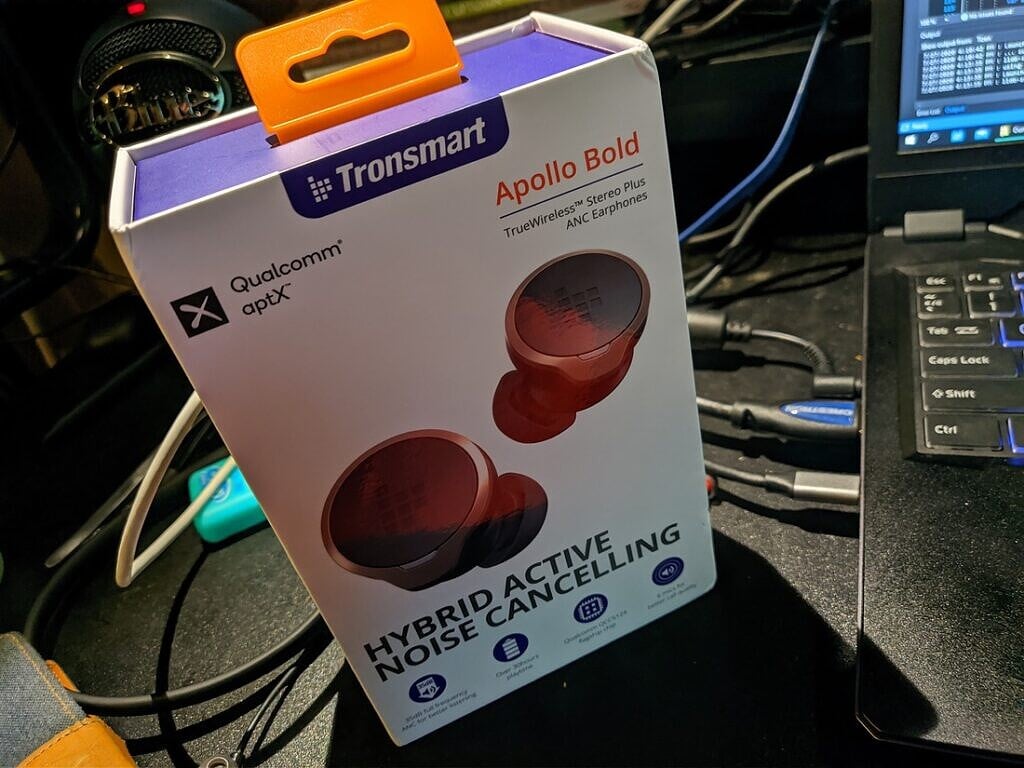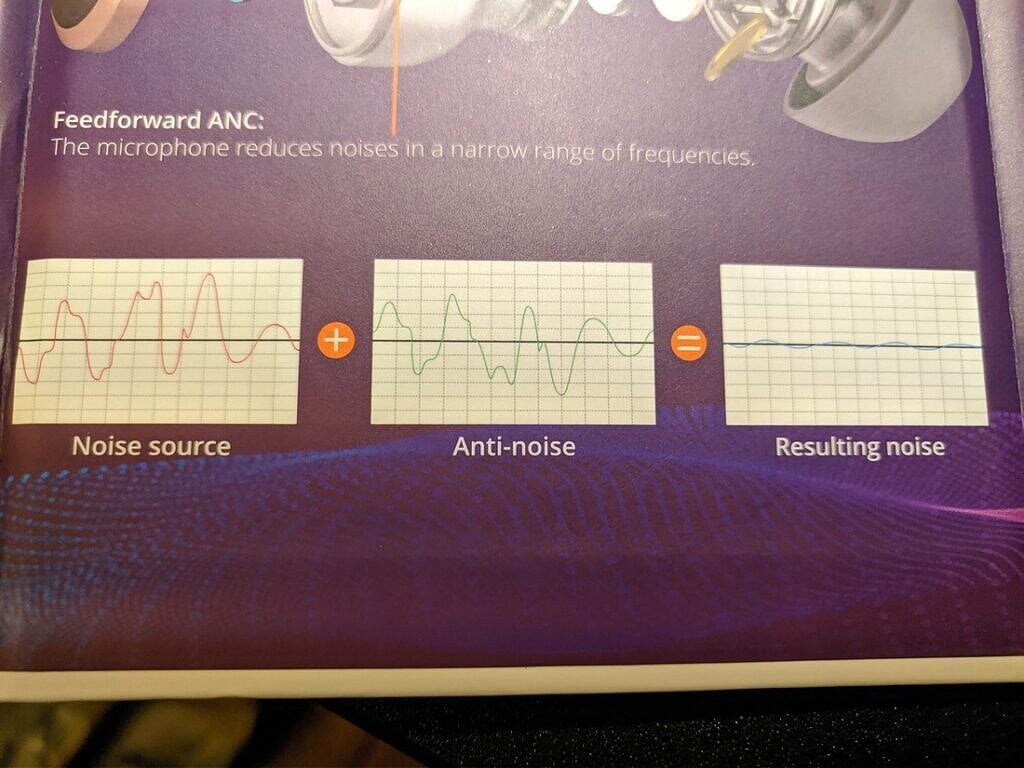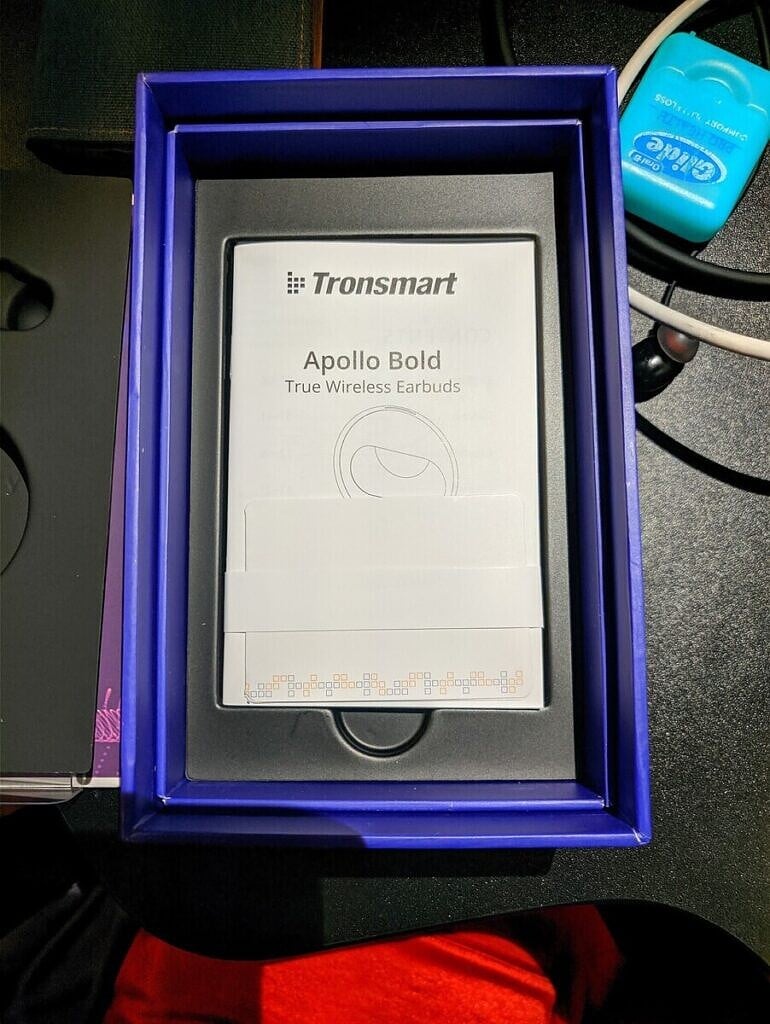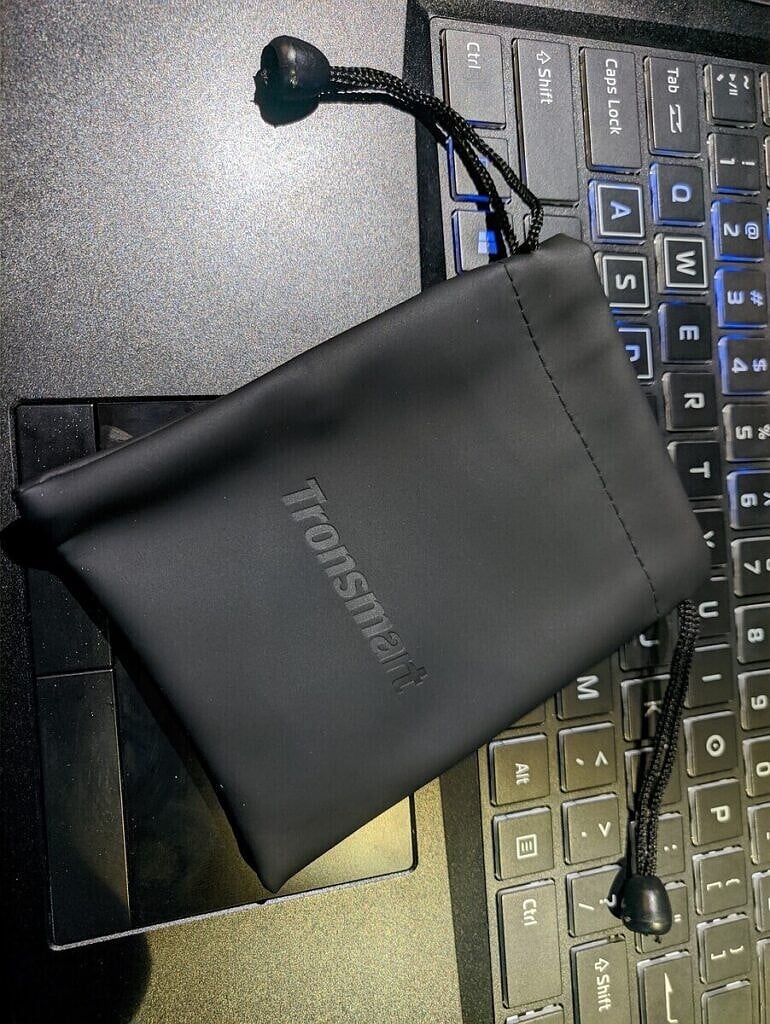Have you ever thought to yourself, “I wish I had some Bluetooth earbuds, but I’m not sure what to buy”? If so you’re probably overwhelmed by the number of truly wireless earbuds on the market these days. We’ve used and reviewed a fair few of them, and today, we’re going to be reviewing the Tronsmart Apollo Bold truly wireless Bluetooth earbuds. These are Tronsmart’s foray into the flagship earbud space, with the advertised features and specs to match.
What’s In the Box & Design
The Tronsmart Apollo Bold comes in some pretty fancy packaging, marking a significant departure from Tronsmart’s usual basic purple-and-orange cardboard. The box opens like a book, with a magnet holding it closed. On the inside of the cardboard, there’s a whole bunch of text about how the Apollo Bold work, and what active noise cancellation does. Moving to the right side, there’s a clear plastic window of sorts showing you the earbuds and charging case, all snapped into fitted holes in a sheet of black plastic. Lifting that up reveals the manuals and warranty card. Underneath those are the replacement earbud tips and a charging cable on top of their own black plastic sheet. Underneath that layer is a handy little vinyl carrying bag for the earbuds.
There are a lot of layers in this box, and it’s clear that a lot of thought went into this packaging. The box isn’t what’s important, though. We’re talking about audio science here, not packing science. Let’s talk about the earbuds.
Actually, let’s talk about the case, first; it’s pretty nice. It’s a simple, low-profile black disc, with a magnetic hinged cover. On the front, there’s a little charge and battery indicator light, right underneath the grip for opening the lid. On the back is the USB-C charging port, which is the only way to charge it as there are no wireless charging coils. Opening the magnetically-latched lid, the hinge feels a little flimsy. Like the Realme Buds Q, it moves back and forth a little bit, which is kind of worrying at this price point.
After some difficulty, I was able to pull the earbuds out of the plastic and put them into the case to charge, which was nice and easy. These earbuds are big. They’re not heavy, though, which is impressive for the size. There are a few reasons for the large size. For one, it means more space for bigger batteries, which explains the advertised 7 hours of playback with active noise cancellation enabled. The earbuds also have large touchpads on each earbud, making them easy to tap.
Once the earbuds were charged, I tried to take them out to pair. The Tronsmart Apollo Bold may be easy to put into the case, but I can’t say the same for taking them out. Something about the way they rest in the case just makes it difficult to get them back out. Luckily, that’s really the only issue I had. Pairing them to my laptop was really easy. I just had to take them out of the case and they were discoverable. Now, I’ve said before—and I’ll keep saying—that I don’t like case-based pairing. I shouldn’t have to dig out my case to connect to a different device. And at first glance, it seemed like Tronsmart had removed the touchpad-based gesture for pairing that older models had. They haven’t, though, and I’ll talk about that in the Controls section.
Like a lot of truly wireless earbuds, the Tronsmart Apollo Bold have audio indicators to tell you when the mode changes. The cues here come in the form of short voice recordings and simple sounds. You’re told when the earbuds turn on and when you change the sound mode, but only get beeps when in pairing mode or when connecting to a device. The combination here is strange, and I think Tronsmart should have stuck with playing either voice recordings or sounds. There’s also no disconnect indicator, so if the Tronsmart Apollo Buds disconnect and you aren’t listening to any audio, you won’t know.
Tronsmart Apollo Buds Specifications
The Tronsmart Apollo Buds are flagship-grade earbuds, set to compete with the likes of the Samsung Galaxy Buds Plus.
Flagship-grade earbuds need flagship-grade specs, and Tronsmart seems to deliver, but you can judge for yourself:
| Specification | Tronsmart Apollo Buds |
|---|---|
| Silicon | Qualcomm QCC5124 with support for TrueWireless Stereo Plus |
| Bluetooth Version | 5.0 |
| Bluetooth Range | 15m/50ft |
| Codecs | aptX, AAC, SBC |
| Active Noise Cancellation | 35dB |
| Driver Size | 10mm |
| Frequency Range | 20Hz – 20KHz |
| IP Rating | IP45 |
| Battery Capacity | Per Earbud: 85mAh
Case: 500mAh |
| Play and Charge Times | Play Time:
Charge Time:
|
| Dimensions | Per Earbud:
Case:
|
| Weight | Per Earbud: 7g/0.24oz
Case: 54g/1.9oz |
Controls
In my opinion, one of the most important aspects to nail for truly wireless earbuds are the controls. Fortunately, I think Tronsmart agrees with me there. Just like the Spunky Pro and Spunky Beat, the Tronsmart Apollo Bold have quite a range of gesture-based controls. Here’s a full list:
- Triple-tap the left or right earbud to cycle the audio mode.
- Double-tap the left or right earbud to play or pause audio.
- Double-tap the left or right earbud to answer or end a call.
- Single-tap the left earbud to lower the device volume.
- Single-tap the right earbud to raise the device volume.
- Hold the left earbud for 2 seconds to go to the previous track.
- Hold the right earbud for 2 seconds to go to the next track.
- Hold the left or right earbud for 2 seconds to reject an incoming call.
- Single-tap, then hold for 3 seconds to activate the device’s voice assistant.
I love seeing all these options. Whereas so many truly wireless earbuds come with only two gestures and maybe 3 actions, Tronsmart went all-in with as many controls as possible. And it’s not like they’ve sacrificed reliability for all these controls, either. For the most part, gesture recognition is reliable; certainly more so than the Amazfit PowerBuds, which only have two gestures. The large touchpads really help with gesture detection.
The one gesture that I didn’t list above is the one to enter pairing mode. If you tap three times and then hold for 2-3 seconds on the third tap on one earbud, it enters pairing mode. Do this gesture on both earbuds at the same time and they’ll enter unified pairing mode. If you want to pair only one at a time, the other one needs to be in the case and the case needs to be closed. Otherwise, the gesture just won’t do anything. This is really nice to see as a feature since it means you don’t need the case if you just want to quickly switch connections between paired devices.
I’m not fond of every gesture, though. The gesture to go to the previous track has problems. It’s not that it’s unreliable, but rather because it’s a flawed design. On most devices I’ve used that support media controls, the Previous Track action serves two purposes: either go to the previous track, or, if the current track is 2 or more seconds in, go back to the beginning. Can you spot the problem? Tronsmart assigned the previous track gesture to a 2-second long-press. It’s difficult to use it to actually go back a track. This is odd behavior, especially since the previous earbuds I’ve used from Tronsmart use a tap-based gesture to go to the previous track.
And that brings me to the final point: app support. Tronsmart’s app is said to do quite a lot of stuff. You can:
- update the earbud firmware.
- customize what the gestures do.
- modify the default sound equalization.
Those sound like some pretty useful features, and I’d love to use this app. If I had one.
Unfortunately, the app isn’t available yet. Tronsmart says it’s going to be available in September, but as of September 5th, it’s not available. If after reading this review you’re considering purchasing the Tronsmart Apollo Bold, I recommend you hold off until the app goes live.
Ergonomics & Usage
Tronsmart advertises 7 hours of battery life with ANC enabled on the Apollo Bold, but are they comfortable to wear for that many hours?

When I first put the earbuds in, they didn’t really feel like they were in. I thought maybe it was because the rubber tips were the wrong size, but the other sizes were worse for me. This isn’t really that big an issue, though. After a while, I forget they’re even in; they never fall out and are plenty comfortable, even after a few hours.
And it’s a good thing they don’t fall out since the Tronsmart Apollo Bold has a sensor for wear detection, ie. the auto-play/pause feature seen in a lot of higher-end earbuds. Take one out of your ear, and your music will pause. Put them back in, and it’ll resume. The wear detection is also surprisingly reliable and quick to respond. As soon as you take them out, your music is paused. Personally, I don’t like wear detection as I like to keep Spotify running in the background for when I need it. But if I’m on a voice call and I take the earbuds out for even a second, Spotify starts playing as soon as I put them back in. I get the appeal of having your music automatically pause and play, but it’s not for me. Hopefully, the app will have an option to disable it.
Now, the Bluetooth range. Tronsmart says the connection goes up to 50 feet. For my unit, that hasn’t been the case. If I lose line of sight and move more than 7 feet away from whatever device the Apollo Bold is connected to, the sound starts dropping out. This isn’t the case for other earphones I’ve used like the OPPO Enco Q1. Weirdly, the earbuds don’t seem to actually disconnect when this happens—the audio just stops working. Call me crazy, but I don’t think a difference of 43 feet is within the manufacturing margin of error. This could be because my unit is defective in some way, but it’s something you should check for.
If you want to use these earbuds for a phone or VoIP call, then go right ahead, because the Tronsmart Apollo Bold are passable. While the headset mode (obviously) doesn’t sound very good, it’ll be good enough for a phone call and even some VoIP calls. These being earbuds, the microphones aren’t exactly studio quality but, again, if you’re just on a call, the other people will be able to hear you just fine. That’s more I can say for some other wireless earbuds I’ve tested.
Next up, fitness features. The Tronsmart Apollo Bold doesn’t have any fancy features like a heart rate sensor, but they are IP45-rated. I wouldn’t take them for a swim, but a light splash shouldn’t be an issue. You also won’t have to worry about frying them if you’re out running on a 95°F day.
You might like another feature that the Tronsmart Apollo Bold offers: independence. Like a lot of truly wireless earbuds, you can take one earbud out of the case and use it while the other one is charging. Like some others, either earbud can do this. But that’s not all, the Tronsmart Apollo Bold work completely independently of each other. If you want, you can pair the left earbud to your phone and the right one to your laptop. Personally, I don’t really have any use for this feature. But when the only difference it makes in normal usage is seeing 2 entries for “Tronsmart Apollo Bold” in your Bluetooth device list, I think it’s a great feature to include.
This is made possible by the Qualcomm QCC5124 Bluetooth chip which features support for Qualcomm’s TrueWireless Stereo Plus technology. As Tronsmart explains: “[the] Tronsmart Apollo Bold uses TrueWireless Stereo Plus synchronous signal transmission technology to ensure left and right earbuds receive Bluetooth signal simultaneously. Most TWS earbuds including AirPods Pro uses TrueWireless stereo technology so the main earbud will receive the signal first and then transmit to the other earbud, causing a delay.”
Overall, the Tronsmart Apollo Bold are pleasant in daily usage. Everything except the Bluetooth range works well, and there are some nice quality-of-life features that not a lot of competitors have.
Battery Life & Charging
If you’ve looked at the spec sheet I posted above, you’ve seen that Tronsmart advertises two battery life estimates: 7 hours with active noise cancellation on and 10 hours without. Unfortunately, with the COVID-19 pandemic and university, it’s a little difficult to find a time where I can use earbuds for a continuous 10-hour stretch (and time it), so I can’t say whether or not Tronsmart’s advertised times are accurate. What I can say, though, is that they last at least 5-6 hours with active noise cancellation enabled.
Even if I hit the maximum battery life without noticing, 5-6 hours with ANC is still ahead of or equal to a lot of the competition. Apple’s AirPods Pro can only go for 4.5 hours with active noise cancellation, while Samsung’s Galaxy Buds Live advertise 6 hours. And the Tronsmart Apollo Bold are significantly cheaper than both.
Shifting focus to charging, I wish it was faster. Tronsmart didn’t equip the case with any sort of fast charging technology, and you can see in the specs sheet that it takes quite a while to fully charge the Apollo Bold. While I’m not the type of person to be bothered by this downtime (I can just charge mine overnight), I can see why this would be a pretty big downside for many people.
All is not lost, though. Tronsmart says that a 10-minute charge will get you 1 hour of playback. So while a full charge may take a while, you can at least do a quick-top-up.
Sound
Plenty of controls and a generally comfortable fit are all well and good, but they don’t really mean much if the sound is terrible. So how good is the audio quality in the Tronsmart Apollo Bold? Pretty good.
In general, the quality is great. My only issue is that Tronsmart set the EQ to be a little heavy on the bass. It doesn’t make the sound muddy or anything, and you can still hear higher notes just fine. It’s just a little too boomy for my taste. Once the app comes out, I’m definitely going to be changing the EQ profile to lower the bass. And if you want it, the Tronsmart Apollo Bold get plenty loud. I can’t put them above about 45% before they’re too loud for me.
Now for the active noise cancellation. The Apollo Bold are Tronsmart’s first truly wireless earbuds that have active noise cancellation onboard, and it works well. Tronsmart advertises a 35dB reduction in ambient noise. While I can’t scientifically test that, I can say I’m happy with how much sound they block.
If you don’t want noise cancellation enabled at a particular moment, though, the Tronsmart Apollo Bold come with two other sound modes: ambient and passive. Ambient mode is similar to the passthrough mode on the Apple AirPods Pro. It uses the mics normally used for noise cancellation to instead stream the environment directly to your ears. This can be useful if you’re on a call or if you need to be able to hear your surroundings. It’s obviously not the same as just taking the earbuds out, but it’s nice when you don’t want to take them out of your ears. And, unlike the ambient mode on the Amazfit PowerBuds, ambient mode on the Tronsmart Apollo Bold has no noticeable delay.
Then there’s the passive mode. This makes the Tronsmart Apollo Bold act like normal earbuds. There’s no noise cancellation or audio passthrough; just passive noise isolation. If you don’t need extra quiet or extra noise, this is the mode for you. It also has the advantage of providing an extra 3 hours of battery life compared to the noise cancellation mode.
Finally, something all Bluetooth earbuds deal with: audio delay. Unfortunately, the delay on the Tronsmart Apollo Bold is noticeable. It’s nowhere near as bad as, say, the Realme Buds Q, but if you’re watching a video, you’re going to see the desync. Maybe it’s the active noise cancellation causing the delay, though? Unfortunately, no. With or without noise cancellation active, the delay is still pretty noticeable. It might be slightly better with noise cancellation off, but not by much. You can test the delay for yourself using one of many apps available on the Play Store.
Earbuds Delay Test (Free+, Google Play) →
Tronsmart did a pretty good job with the audio quality here. While that’s something you should expect from a $100 pair of earbuds, it’s not always the case. The sound might have a little too much bass for my liking, but it’s still clear and should have equalization customization available later this year.
Tronsmart Apollo Bold – Pricing & Availability
Tronsmart does a good job of making their earbuds widely available. You can buy the Tronsmart Apollo Bold for about $99 from Amazon and other online retailers, and they ship to over 200 countries. If you want some, you should have no trouble buying a pair.
Tronsmart Apollo Bold
- With Qualcomm’s flagship QCC5124 chip, the Tronsmart Apollo Bold are one of the few truly wireless earbuds to support Truewireless Stereo Plus.
Conclusion
The Tronsmart Apollo Bold are Tronsmart’s first “flagship” truly wireless earbuds. In the past, the company has focused mainly on mid-range and budget options (which had some pretty good value for money). Overall, I think these earbuds are pretty solid.
You’ve got tons of reliable controls, good audio quality, water resistance, and plenty of extra features, all in a relatively small, comfortable package. Of course, the Tronsmart Apollo Bold do have some issues. The abysmal range on my unit is hard to get over (hopefully it’s just a defect with my particular unit), and the slow charging is going to be an issue for some people.
However, if you’re looking for a pair of higher-end Bluetooth earbuds that don’t break the bank and you’re fine with the compromises I’ve listed, then the Tronsmart Apollo Bold are arguably a good choice. Just wait for the app to come out, though.
The post Tronsmart Apollo Bold Review — Affordable, Premium TWS Earbuds with Qualcomm’s TrueWireless Stereo Plus appeared first on xda-developers.













